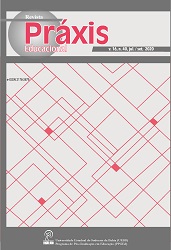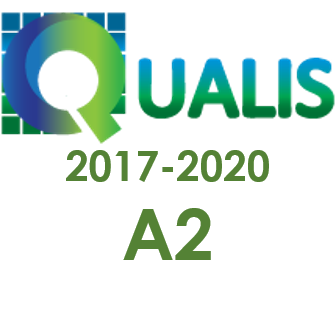WHY, TO MANIPULATE REALITY, DO WE NEED TO REDUCE IT?
DOI:
https://doi.org/10.22481/praxisedu.v16i40.6909Keywords:
Manipulation, Humanity, RealityAbstract
It is difficult to exaggerate the importance of this “ontological and epistemological assumption”, which is at the heart of positively focused, aggressively reductionist (to the “logical- experimental” and materialistic) Eurocentric science (“method dictatorship” - only what is appropriate is real) Full name). However, it is also difficult to overstate the importance of this modernist view of science, one of the most striking responsible for Western technological success, a success that makes challenging the positivism of the enterprise challenging. Let us take into account that digital technology reissues, with unprecedented forcefulness, the linear, sequential, formal ethos of modernist science, in a context of superlative efficiency: computer is a formidable machine (“superintelligent”), to the point of being able, according to many, to supplant in intelligence the human intelligence.
Downloads
Metrics
References
ALTHUSSER, L. 1971. La Revolución Teórica de Marx. Siglo XXI, México.
ALTHUSSER, L. 1980. Ideologia e Aparelhos ideológicos do Estado. Editorial Presença, Lisboa.
BELLAH, R.N. 2011. Religion in Human Evolution – From the Paleolithic to the axial age. The Belknap Press of Harvard University Press, Cambridge.
BOURDIEU, P. & PASSERON, J.C. 1975. A Reprodução - Elementos para uma teoria do sistema educativo. Francisco Alves, Rio de Janeiro.
CHOPRA, D., PENROSE, R., CARTER, B. et alii. 2015. How consciousness became the universe: Quantum physics, cosmology, relativity, evolution, neuroscience, parallel Universes. Amazon, N.Y.
CHRISTIAN, B. & GRIFFITHS, T. 2016. Algorithms to live by: The computer science of human decisions. Picador, N.Y.
DAMASIO, A. 2018. The strange order of things: Life, feeling, and the making of cultures. Pantheon, N.Y.
DANTZIG, T. 2005. Number – The language of science - http://www.engineering108.com/Data/Engineering/Maths/Number_the_language_of_science_by_Joseph-Mazur_and_Barry-Mazur.pdf
DAVIES, P. & GREGERSEN, N.H. (Eds.). 2011. Information and the nature of reality. Cambridge U. Press.
DAVIES, P. & GREGERSEN, N.H. (Eds.). 2011. Information and the nature of reality. Cambridge U. Press.
DEMO, P. 1995. Metodologia científica em ciências sociais. Atlas, São Paulo.
DEMO, P. 2001. Pesquisa e informação qualitativa. Papirus, Campinas.
DEMO, P. 2011. Forças e fraquezas do positivismo – https://docs.google.com/document/pub?id=1eew1D-Lz18JrIGLMkk5qlN4b87EzlwUFF--E0Gsc3uE
DEMO, P. 2018. Educação como estratégia de ranqueamento social – Retomando a sociologia da educação reprodutiva, hoje – https://docs.google.com/document/d/e/2PACX-1vRP-_QGPYiReXLcH0rObkh7u7HuWSMC28vvtms3H76vMsmsRqzPwhoax_ws3HGy4-Fqzn_yzLz4MRf8/pub
ENGELS, F. 1979. Dialética da Natureza. Paz e Terra, Rio de Janeiro.
FAYER, M.D. 2010. Absolutely small: How quantum theory explains our everyday world. AMACOM. Amazon.
FREIRE, P. 1997. Pedagogia da Autonomia – Saberes necessários à prática educativa. Paz e Terra, Rio de Janeiro.
FRY, H. 2018. Hello World – Being human in the age of algorithm. Norton & Company. N.Y.
GERRISH, S. & SCOTT, K. 2018 How smart machines think. The MIT Press.
GIERE, R.N. 1999. Science without Laws. The University of Chicago Press.
GLEICK, J. 2011. The Information: A history, a theory, a flood. Pantheon, N.Y.
GROSZ, E. 2017. Incorporeal: Ontology, ethics, and the limits of materialism. Columbia U. Press, N.Y.
HARARI, Y.N. 2017. Homo Deus – A brief history of tomorrow. Harper, London.
HARARI, Y.N. 2018. 21 Lessons for the 21st century. Spiegel and Grau, N.Y.
HARRIS, S. 2014. Waking up: A guide to spirituality without religion. Amazon, N.Y.
HOFFMAN, D. 2019. The case against reality: Why evolution hid the truth from our eyes. Norton, N.Y.
HUBBARD, D.W. 2010. How to Measure Anything: Finding the Value of Intangibles in Business. Wiley, N.Y.
IOSCHPE, G. 2004. A Ignorância Custa um Mundo - O valor da educação no desenvolvimento do Brasil. Francis, São Paulo.
KAHNEMAN, D. 2011. Thinking, Fast and Slow. Penguin, N.Y.
KAUFFMAN. S.A. 2019. A world beyond physics: The emergence and evolution of life. Oxford U. Press.
LASZLO, E. (with Alexander Laszlo, Deepak Chopra, and S. Grof). 2016. What is reality? The new map of cosmos, consciousness, and existence. SelectBooks, N.Y.
LATOUR, B. & WOOLGAR, S. 2013. Laboratory Life – The construction of scientific facts. Princeton U. Press.
LATOUR, B. 2000. Ciência em Ação – Como seguir cientistas e engenheiros sociedade afora. Editora UNESP, São Paulo.
LATOUR, B. 2001. A Esperança de Pandora. EDUSC, São Paulo.
LATOUR, B. 2013. An Inquiry into Modes of Existence – An anthropology of the moderns. Harvard University Press, Cambridge.
LÉVI-STRAUSS, C. 1967. Antropologia estrutural 1. Tempo Brasileiro, Rio de Janeiro.
LÉVI-STRAUSS, C. 1976. Antropologia estrutural 2. Tempo Brasileiro, Rio de Janeiro.
LIPSON, H. & KURMAN, M. 2016. Driverless: Intelligent cars and the road ahead. The MIT Press, Cambridge.
MANGUEL, A. 1996. Uma História da Leitura. Companhia das Letras, São Paulo.
MARX/ENGELS. 1983. Werke. Vol. 23. Dietz Verlag, Berlin.
NOWAK, M. (with Highfield, R.) 2011. SuperCooperators: Altruism, evolution, and why we need each other to succeed. Free Press, N.Y.
PIAGET, J. 1990. La Construction du Réel chez l’Enfant. Delachaux & Niestlé, Paris.
PLATÃO. 2010. Apologia de Sócrates, o Banquete e Fedro. Folha de São Paulo.
POPPER, K.R. 1959. The Logic of Scientific Discovery. Hutchinson of London, London.
PRIGOGINE, I. & STENGERS, I. 1997. A Nova Aliança. Ed. UnB, Brasília.
PRIGOGINE, I. 1996. O Fim das Certezas – Tempo, caos e as leis da natureza. Ed. UNESP, São Paulo.
SCHNEIDER, S. 2019. Artificial You: AI and the future of your mind. Princeton U. Press.
SHANNON, C.E. & WEAVER, W. 1971. The mathematical theory of communication. The U. of Illinois Press.
SONI, J. & GOODMAN, R. 2017. A mind at play: How Claude Shannon invented the information age. Simon & Schuster.
TEGMARK, M. 2017. Life 3.0: Being human in the age of artificial intelligence. Knopf. N.Y.
THOMAS, A. 2012. Hidden in plain sight: The simple link between relativity and quantum mechanics. Amazon, N.Y.
THOMAS, A. 2018. Hidden in plain sight 10: How to program a quantum computer. Amazon Digital Services, N.Y.
UNGER, R.M. & SMOLIN, L 2014. The singular universe and the reality of time: A proposal in natural philosophy. Cambridge U. Press, Cambridge.
Downloads
Published
How to Cite
Issue
Section
License

This work is licensed under a Creative Commons Attribution-ShareAlike 4.0 International License.
You are free to:
Share - copy and redistribute the material in any medium or format; Adapt - remix, transform, and build from the material for any purpose, even commercially. This license is acceptable for Free Cultural Works. The licensor cannot revoke these freedoms as long as you follow the terms of the license.
Under the following terms:
Attribution - You must appropriately give credit, provide a link to the license, and indicate if any changes have been made. You may do so in any reasonable way, but not in a way that suggests that you or your use is endorsed by the licensor.
There are no additional restrictions - You cannot apply legal terms or technological measures that legally restrict others to make any use permitted by the license.










